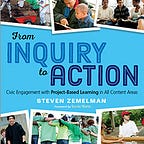The Missing Link in Many Civics and PBL Education Efforts — ACTION!
OK, so more online resources and teacher stories are promoting civics education and project based learning that focuses on civic issues. But some avoid ever having students ACT to address the concerns they research, write, and speak about.
For example, Supreme Court Justice Sandra Day O’Connor founded the website iCivics in 2009, to help restore civic education in our nation’s schools. It’s stocked with lessons on the various parts and levels of American government, along with games and simulations that propose, “Don’t just learn civics — play civics! Run for president. Pass new laws. Argue real cases.” But even in the lesson section titled “Citizenship and Participation,” while students investigate and write arguments on an issue, the work never moves out of the classroom. Even tempting subsections like “Activate” don’t involve actual effort in the school or community.
Then there are individual teachers enthusiastically sharing stories of student engagement boosted by project based learning. Here for example is special education teacher Jamie Kumiega explaining her efforts in an article in the Web education magazine, The Journal:
I use PBL to help bring the outside world into the classroom, too. For example, during a unit on the environment, my students acted as city park planners. I was able to customize the lesson for my students and make them think deeply about who uses parks, what sort of animals live in parks, what they eat, where they sleep at night and more. When lessons use examples that students can relate to, they’re able to connect the dots and bring relevance to what they’re learning.
Kumiega is obviously a thoughtful and caring teacher working to meet the varying learning needs of all her students. The activity sounds engaging and valuable. But why not connect the kids with an actual park need and park district personnel in their area? Not only would the project be even more exciting, but students would experience the satisfaction of making a positive difference in their community. And in the process they’d learn additional invaluable civics lessons about how government and organizations work and how to influence them in constructive ways.
Why it doesn’t happen
I expect there are a number of reasons why the action step doesn’t get included more often:
- The focus on standards and testing can suck up all the oxygen in the classroom, so educators aren’t likely to think about connecting their classroom with the wider world.
- Many are overwhelmed with new initiatives some districts introduce one on top of another in search of the educational silver bullet for higher test scores.
- Similarly, others feel their day is already overstuffed, leaving no room for a more complex, publicly-oriented project.
- Some may not realize the increased motivation and learning that occurs through students’ real-world interactions.
- Others may worry that students’ civic action may involve politically sensitive issues that could get the teacher in hot water.
- Still others have yet to witness students’ ability to plan and execute an action project.
While not all these concerns are easily overcome, those of us doing the work of student civic engagement see how powerful it is in the classroom — how motivated and resourceful students become, how much it improves their attitude toward school and learning, and even how it develops their literacy skills and achievement. We know that many of the issues students want to tackle aren’t controversial or political at all, concerns like playground safety, bullying, student health and healthy eating, homelessness And we’re reminded how important this effort is — to understand this, read Guardian of Democracy: The Civic Mission of Schools document originally created by the Carnegie Corporation of New York.
Fortunately!
A growing number organizations across the country are working to help teachers realize the value of student civic action and how to build it into their curricula. Some districts, like Chicago Public Schools, even have programs and staff devoted to this work. I’ve listed many of these groups before, but here are eight of my favorites to investigate — quick, before summer learning time is over (!):
- Chicago Public Schools Department of Social Science and Civic Engagement
- Community Works Institute
- Earth Force
- Facing History and Ourselves
- Generation Citizen
- Mikva Challenge
- Project Citizen
- Teaching Tolerance
Now more than ever, our students need this kind of learning in order to actively become — right in their classrooms — the responsible citizens our country needs.
